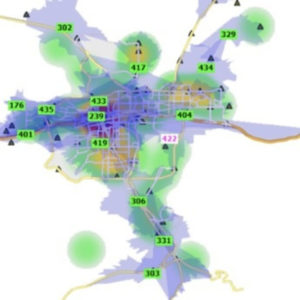How REMSA Responds
One of the most common questions about REMSA is “Why do I see an ambulance parked at the corner of this street and that street every day?”
While community members are probably pleased to see ambulances out and about, they are also perplexed as to why they are often in the same place, day after day. Allocating REMSA’s resources around the community in an efficient and effective way is at the heart of how REMSA strategically deploys its units around the community in anticipation of where that ambulance will be needed. REMSA uses a model called dynamic deployment and we strongly believe it’s the best way to provide mobile health care for our region.
As Washoe County continues to see an increase in jobs and the number of occupied households, building and maintaining critical infrastructure such as emergency medical services is an important part of community health and resilience. Many people ask how REMSA continues to provide fast, clinically-excellent ambulance responses, even as the region grows. The explanation is complex and multi-faceted and focuses a great deal on efficiency and being a responsible steward of its non-profit, non-taxpayer supported finances.
One of the key differentiators is that REMSA uses the system status management deployment model. This means that ambulances are geographically deployed throughout Washoe County using predictive analytics – information based on projected demand by the time of day and day of the week using historical demand data. Since ambulances respond to people in need of medical attention, and populations are transient – people move from home to work and back, geographic demand patterns vary. Rather than posting at a fixed station, the system status management model posts ambulances to street corners or areas of town on an hour to hour basis. The posts are selected based on those predictive analytics and are anticipated to provide the best response times for the projected demand at that time of day. This model allows REMSA to match resources to demand more accurately than using only a static model of fixed staffing and fixed stations.

This map shows the predictive analytics used to determine how ambulances are posted. The darker blue, magenta and red areas indicate the highest potential areas for an emergency. The green numbers indicate an available ambulance.
By predicting patterns of human behavior, REMSA is able to put ambulances where and when we think they will be needed. As a high-performance EMS system, using this deployment model allows us to be nimble and to respond to the needs of the region. For example, as a destination location, Washoe County has significant influxes of people throughout the year. Mobile health resources can easily and quickly be shifted and reallocated to provide appropriate coverage based on population demand for things like special events. Because of how the region has grown, REMSA has also added four fixed posts throughout Washoe County. These locations are just outside of more densely populated suburban areas in Sparks, south Reno and north Reno.
Using resources effectively through dynamic deployment enhances the quality and experience of care for the patient by allowing REMSA to do the most amount of good for the most amount of people with the least amount of resources.
